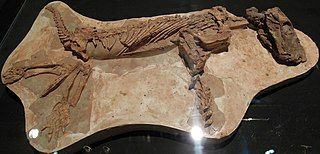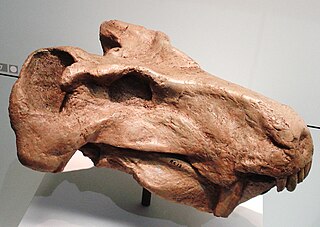
A therapsid is a member of the clade Therapsida which is a major group of eupelycosaurian synapsids that includes mammals and their ancestors and relatives. Many of the traits today seen as unique to mammals had their origin within early therapsids, including limbs that were oriented more underneath the body, as opposed to the sprawling posture of many reptiles and salamanders.

Dinocephalians are a clade of large-bodied early therapsids that flourished in the Early and Middle Permian between 279.5 and 260 million years ago (Ma), but became extinct during the Capitanian mass extinction event. Dinocephalians included herbivorous, carnivorous, and omnivorous forms. Many species had thickened skulls with many knobs and bony projections. Dinocephalians were the first non-mammalian therapsids to be scientifically described and their fossils are known from Russia, China, Brazil, South Africa, Zimbabwe, and Tanzania.

Gorgonopsia is an extinct clade of sabre-toothed therapsids from the Middle to Upper Permian roughly 265 to 252 million years ago. They are characterised by a long and narrow skull, as well as elongated upper and sometimes lower canine teeth and incisors which were likely used as slashing and stabbing weapons. Postcanine teeth are generally reduced or absent. For hunting large prey, they possibly used a bite-and-retreat tactic, ambushing and taking a debilitating bite out of the target, and following it at a safe distance before its injuries exhausted it, whereupon the gorgonopsian would grapple the animal and deliver a killing bite. They would have had an exorbitant gape, possibly in excess of 90°, without having to unhinge the jaw.

Biarmosuchia is an extinct clade of non-mammalian synapsids from the Permian. Biarmosuchians are the most basal group of the therapsids. They were moderately-sized, lightly built carnivores, intermediate in form between basal sphenacodont "pelycosaurs" and more advanced therapsids. Biarmosuchians were rare components of Permian ecosystems, and the majority of species belong to the clade Burnetiamorpha, which are characterized by elaborate cranial ornamentation.

Inostrancevia is an extinct genus of large carnivorous therapsids which lived during the Late Permian in what is now European Russia and South Africa. The first known fossils of this gorgonopsian were discovered in the Northern Dvina, where two almost complete skeletons were exhumed. Subsequently, several other fossil materials were discovered in various oblasts, and these finds will lead to a confusion about the exact number of valid species in the country, before only three of them were officially recognized : I. alexandri, I. latifrons and I. uralensis. More recent research carried out in South Africa has discovered fairly well-preserved remains of the genus, being attributed to the species I. africana. The whole genus is named in honor of Alexander Inostrantsev, professor of Vladimir P. Amalitsky, the paleontologist who described the taxon.

Therocephalia is an extinct clade of eutheriodont therapsids from the Permian and Triassic. The therocephalians ("beast-heads") are named after their large skulls, which, along with the structure of their teeth, suggest that they were carnivores. Like other non-mammalian synapsids, therocephalians were once described as "mammal-like reptiles". Therocephalia is the group most closely related to the cynodonts, which gave rise to the mammals. This relationship takes evidence in a variety of skeletal features.

Dinogorgon is a genus of gorgonopsid from the Late Permian of South Africa and Tanzania. The generic name Dinogorgon is derived from Greek, meaning "terrible gorgon", while its species name rubidgei is taken from the surname of renowned Karoo paleontologist, Professor Bruce Rubidge, who has contributed to much of the research conducted on therapsids of the Karoo Basin. The type species of the genus is D. rubidgei.

Sauroctonus is an extinct genus of gorgonopsian therapsids who lived during the end of the Middle Permian in what is now European Russia. The first fossils, discovered in Tatarstan, were first considered to belong to a new species of the South African genus Arctognathus, named A. progressus in 1938. The taxon will be designated as such until 1940, when it will be assigned to the genus Inostrancevia by Ivan Yefremov, before being definitively classified in a separate genus erected by Alexey Bystrow in 1955. The most complete known fossils of S. progressus include cranial and postcranial elements currently all recorded in Tatarstan. These elements show that the animal is a rather medium-sized gorgonopsian.

Viatkogorgon is a genus of gorgonopsian that lived during the Permian period in what is now Russia. The first fossil was found at the Kotelnich locality near the Vyatka River and was made the holotype of the new genus and species V. ivachnenkoi in 1999. The generic name refers to the river and the related genus Gorgonops—the gorgons of Greek mythology are often referenced in the names of the group. The specific name honors the paleontologist Mikhail F. Ivakhnenko. The holotype skeleton is one of the most complete gorgonopsian specimens known and includes rarely preserved elements such as gastralia and a sclerotic ring. A larger, but poorly preserved specimen has also been assigned to the species.

Rubidgea is a genus of gorgonopsid from the upper Permian of South Africa and Tanzania, containing the species Rubidgea atrox. The generic name Rubidgea is sometimes believed to be derived from the surname of renowned Karoo paleontologist, Professor Bruce Rubidge, who has contributed to much of the research conducted on therapsids of the Karoo Basin. However, this generic name was actually erected in honor of Rubidge's paternal grandfather, Sydney Rubidge, who was a renowned fossil hunter. Its species name atrox is derived from Latin, meaning “fierce, savage, terrible”. Rubidgea is part of the gorgonopsian subfamily Rubidgeinae, a derived group of large-bodied gorgonopsians restricted to the Late Permian (Lopingian). The subfamily Rubidgeinae first appeared in the Tropidostoma Assemblage Zone. They reached their highest diversity in the Cistecephalus and Daptocephalus assemblage zones of the Beaufort Group in South Africa.

Burnetia is an extinct genus of biarmosuchian therapsids in the family Burnetiidae, from the Late Permian of South Africa. Burnetia is known so far from a single holotype skull lacking the lower jaws described by South African paleontologist Robert Broom in 1923. Due to erosion and dorsoventral crushing, features of the skull are hard to interpret. Stutural lines are further distorted by the unusual shape of the skull roof, including many bosses and protuberances.

Megawhaitsia is an extinct genus of large therocephalian therapsids who lived during the Late Permian (Wuchiapingian) in what is now Eastern Europe. The only known species is M. patrichae, described in 2008 from several fossils discovered in various oblasts of European Russia. The fossils are representative of a large animal whose skull size is estimated to be 40–50 cm (16–20 in) long.

Eriphostoma is an extinct genus of gorgonopsian therapsids known from the Middle Permian of Tapinocephalus Assemblage Zone, South Africa. It has one known species, Eriphostoma microdon, and was first named by Robert Broom in 1911. It is the oldest known gorgonopsian and among the smallest and most basal members of the clade.

Smilesaurus is an extinct genus of gorgonopsian known from Africa. It lived during the Late Permian. It contains the single species S. ferox.
Katumbia is a genus of dicynodont from Late Permian (Changhsingian) Kawinga Formation of the Ruhuhu Basin, Tanzania. and possibly the Upper Madumabisa Mudstone Formation of the Luangwa Basin, Zambia. The type species, K. parringtoni, was originally referred to the genus Cryptocynodon, which is now recognized as a junior synonym of Endothiodon.
"Dixeya" nasuta is a species of the predatory gorgonopsian therapsids from the Late Permian of East Africa, known from fossils found in what is now Tanzania. The species has a complicated taxonomic history, it was originally named as a second species of the genus Dixeya which is now considered a junior synonym of Aelurognathus. "D." nasuta itself, however, was not moved to Aelurognathus, and although it was instead tentatively referred to Arctognathus at first it has since been recognised to not belong to this genus either. This situation leaves "Dixeya" nasuta without a formal genus name. It was proposed to belong to a new distinct genus, named "Njalila", that was informally proposed for the species in a PhD thesis, but this name has not yet been formally published and is currently a nomen nudum. "D." nasuta has been characterised from other gorgonopsians by a combination of its straight snout profile, upturned and 'pinched' nose, and curved jaw margin.

Rubidgeinae is an extinct subfamily of gorgonopsid therapsids known only from Africa. They were among the largest gorgonopsians, and their fossils are common in the Cistecephalus and Daptocephalus assemblage zones of the Karoo Basin. They lived during the Late Permian, and became extinct at the end of the Permian.
Leogorgon is an extinct genus of dubious therapsid from the Late Permian Sokolki Faunal Assemblage of Russia. It was originally classified as a rubidgeine gorgonopsian, and would have been the first member of that clade from outside of Africa if that identification had been valid. However, it may instead be a combination of the tooth of a gorgonopsian and the braincase of a dicynodont, and may be a wastebin taxon.

Nochnitsa is an extinct genus of gorgonopsian therapsids who lived during an uncertain stage of the Permian in what is now European Russia. Only one species is known, N. geminidens, described in 2018 from a single specimen including a complete skull and some postcranial remains, discovered in the red beds of Kotelnich, Kirov Oblast. The genus is named in reference to Nocnitsa, a nocturnal creature from Slavic mythology. This name is intended as a parallel to the Gorgons, which are named after many genera among gorgonopsians, as well as for the nocturnal behavior inferred for the animal. The only known specimen of Nochnitsa is one of the smallest gorgonopsians identified to date, with a skull measuring close to 8 cm (3.1 in) in length. The rare postcranial elements indicate that the animal's skeleton should be particularly slender.
Phorcys is an extinct genus of gorgonopsian that lived during the Middle Permian period (Guadalupian) of what is now South Africa. It is known from two specimens, both portions from the back of the skull, that were described and named in 2022 as a new genus and species P. dubei by Christian Kammerer and Bruce Rubidge. The generic name is from Phorcys of Greek mythology, the father of the Gorgons from which the gorgonopsians are named after, and refers to its status as one of the oldest representatives of the group in the fossil record. Phorcys was recovered from the lowest strata of the Tapinocephalus Assemblage Zone (AZ) of the Beaufort Group, making it one of the oldest known gorgonopsians in the fossil record—second only to fragmentary remains of an indeterminate gorgonopsian from the older underlying Eodicynodon Assemblage Zone.

















